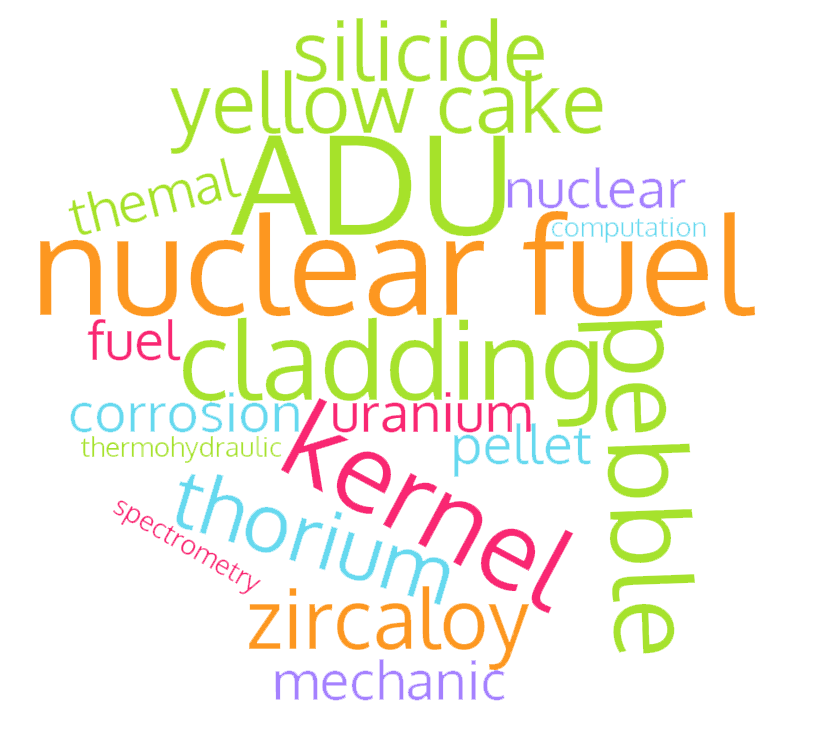KARAKTERISASI SIFAT TERMAL PADUAN AlFe(2,5%)Ni(1,5%) DAN AlFe(2,5%)Ni(1,5%)Mg(1%) UNTUK KELONGSONG BAHAN BAKAR REAKTOR RISET
DOI: http://dx.doi.org/10.17146/urania.2014.20.1.2415
Sari
ABSTRAK
KARAKTERISASI SIFAT TERMAL PADUAN AlFe(2,5%)Ni(1,5%) DAN AlFe(2,5%)Ni(1,5%)Mg(1%) UNTUK KELONGSONG BAHAN BAKAR REAKTOR RISET. Karakterisasi sifat termal telah dilakukan terhadap paduan AlFe(2,5%)Ni(1,5%) dan AlFe(2,5%)Ni(1,5%)Mg(1%). Analisis sifat termal meliputi entalpi, temperatur peleburan dan temperatur perubahan fasa, kapasitas panas serta besaran konduktivitas panas. Tujuan dilakukannya penelitian ini adalah untuk mengetahui karakter sifat termal paduan AlFeNi sebagai alternatif kelongsong bahan bakar nuklir densitas tinggi. Analisis besaran entalpi, temperatur peleburan, temperatur perubahan fasa dan kestabilan panas dilakukan dengan menggunakan Differential Thermal Analysis (DTA) dan untuk menganalisis sifat kapasitas panas digunakan Differential Scanning Calorimetry (DSC) serta alat Termalkonduktometer digunakan untuk mengetahui sifat konduktivitas panas kedua paduan tersebut. Hasil analisis dengan DTA menunjukkan bahwa ke dua paduan tersebut mempunyai kestabilan panas hingga temperatur 650oC. Paduan AlFe(2,5%)Ni((1,5%) mengalami reaksi termokimia 2 (dua) tahap, pada tahap pertama terjadi perubahan aliran panas membentuk puncak endotermik pada temperatur 656,26oC dengan membutuhkan panas sekitar ΔH=56,35 cal/g. Pada temperatur 711,64oC terjadi reaksi tahap ke dua yang menunjukkan terjadinya reaksi secara langsung antara lelehan unsur Al dengan unsur Fe dan Ni pada titik eutektiknya. Reaksi ini membentuk senyawa Al-FeAl3 dan Al-NiAl3 dengan melepaskan panas sebesar ΔH=-13,95cal/g. Paduan AlFe(2,5%)Ni(1,5%)Mg(1%) mengalami reaksi termokimia sebanyak 3 tahap. Reaksi tahap pertama terbentuk puncak endotermik pada temperatur 389,15oC dengan entalpi sebesar ΔH= 1,13cal/g. Pada temperatur 654,52oC terjadi juga reaksi endotermik yang menunjukkan terjadinya perubahan fasa α menjadi (α +liquid) logam Al dengan Mg yang membutuhkan panas sebesar ΔH=2,75cal/g. Reaksi tahap ketiga terjadi pada temperatur 562,41oC yang ditandai dengan terbentuknya puncak endotermik yang menunjukkan proses peleburan logam Al dan Mg, sekaligus terjadi pembentukan senyawa AlMg dengan membutuhkan panas reaksi sebesar ΔH= 56,22cal/g. Hasil analisis kapasitas panas dan konduktivitas panas menunjukkan bahwa penambahan logam Mg 1% meningkatkan kapasitas panas dan konduktivitas panas kedua paduan. Paduan AlFe(2,5%)(Ni1,5%) mempunyai kapasitas panas sebesar 0,60 J/goC pada temperatur 35oC hingga 0,90 J/goC pada temperatur 450oC, sedangkan paduan AlFe(2,5%)Ni(1,5%)Mg1% mempunyai kapasitas panas sebesar 0,64 J/goC pada temperatur 35oC hingga 0,142 J/goC pada temperatur 450oC. Paduan AlFe(2,5%)(Ni1,5%) mempunyai konduktivitas panas sebesar 235 W/moK pada temperatur 25oC hingga 185,5 W/moK pada temperatur 200oC dan paduan AlFe(2,5%)Ni(1,5%)Mg1% mempunyai konduktivitas panas sebesar 240,4 W/moK pada temperatur 25oC hingga 192,3 W/moK pada temperatur 200oC. Namun, kedua paduan tersebut mempunyai kapasitas panas maupun konduktivitas panas yang menurun dengan naiknya temperatur pemanasan.
Kata kunci: Paduan AlFeNi, entalpi, kesetabilan panas, kapasitas panas, dan konduktivitas panas
ABSTRACT
CHARACTERIZATION OF THERMAL CHARACTERISTIC OF AlFe(2,5%)Ni(1,5%) AND AlFe(2,5%)Ni(1,5%)Mg(1%) ALLOYS FOR RESEARCH REACTOR CLADDING. This research deals with thermal characterization of AlFe(2,5%)Ni(1,5%) and AlFe(2,5%)Ni(1,5%)Mg(1%) alloys which previously produced. The thermal characterization includes enthalpy analysis, phase change temperature, heat capacity, and heat conductivity. The enthalpy analysis and phase change temperature and heat stability measurement was done using Differential Thermal Analysis (DTA), while the heat capacity measurement was performed by Differential Scanning Calorimetry (DSC) and the heat conductivity measurement was done using Thermal conductometer. The analysis using DTA shows that both alloys has a thermal stability at 650oC. The AlFe(2,5%)Ni(1,5%) alloy underwent 2 steps of thermochemical reaction. The first thermochemical reaction showed the occuramce of heat flow change forming endothermic peak at 656,26oC and at ΔH=56,35 cal/g. The endothermic reaction indicates the melting of Al contained in the AlFe(2,5%)Ni(1,5%) alloy. The second thermochemical reaction occured at 711,64oC, which indicates that the melted Al directly reacted with Fe and Ni at their eutectic point to form Al-FeAl3 and Al-NiAl3. The occurance of reaction of Al with Fe and Ni was indicated by exothermic thermochemical reaction releasing an amount of heat with appoximate ΔH= -13,95 cal/g. The AlFe(2,5%)Ni(1,5%)Mg(1%) alloy, on the other hand, underwent 3 steps thermochemical reaction. The first reaction resulted in endothermic peak at 389,15oC with enthalpy ΔH= 1,13 cal/g. This endothermic reaction indicates that there is a reaction between Mg and N2 gas contained in the argon used as media for the measurement to form Mg3N2. Endothermic reaction also occured at 654,52oC, which indicates the occurance of phase change point from α phase to α+liquid of Al and Mg requiring ΔH= 2,75 cal/g. The third reaction occured at 562,41oC, which was indicated by endothermic peak. This reaction suggests the burning of Al and Mg to form AlMg with ΔH= 56,22 cal/g. The heat capacity and heat conductivity analysis shows that the addition of 1% Mg may have increased the heat capacity and heat conductivity of both alloys. The heat capacity of AlFe(2,5%)(Ni1,5%) alloy ranged from 0,60 J/goC at 35oC to 0,90 J/goC at 450oC, while the heat capacity of AlFe(2,5%)Ni(1,5%)Mg1% alloy ranged from 0,64 J/goC at 35oC to 0,142 J/goC at 450oC. The heat conductivity analysis showed that the heat conductivity of AlFe(2,5%)(Ni1,5%) ranged from 235 W/moK at 25oC to 185,5 W/moK at 200oC, while the heat conductivity of AlFe(2,5%)Ni(1,5%)Mg1% ranged from 240,4 W/moK at 25oC to 192,3 W/moK at 200oC. It is also studied that heat capacity and heat conductivity of both alloys decrease with increasing heating temperature.
Keyword : AlFeNi alloy, enthalpy, heat stability, heat capacity, and conductivity.
Teks Lengkap:
PDFRefbacks
- Saat ini tidak ada refbacks.
Penerbit: Pusat Riset Teknologi Daur Bahan Bakar Nuklir dan Limbah Radioaktif
Diindeks oleh:









